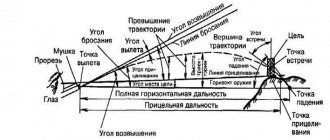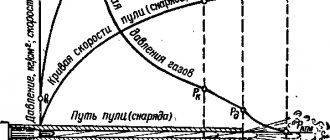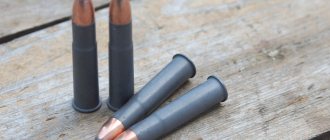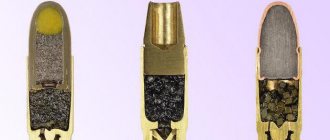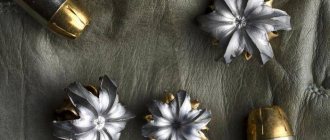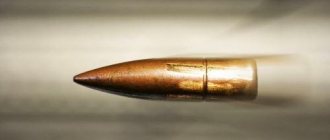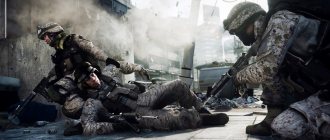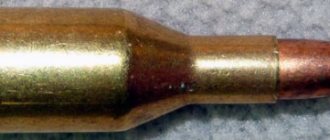ACTION OF THE BULLET ON THE TARGET. BULLET DEATH
ACTION OF THE BULLET ON THE TARGET. BULLET DEATH
The defeat of a live open target when hit is determined by the lethality of the bullet. The lethality of a bullet is characterized by the live force of the impact, that is, the energy at the moment of meeting the target. Bullet energy E depends on the ballistic properties of the weapon and is calculated by the formula:
E = (gx v2)/S
where g is the weight of the bullet;
v is the speed of the bullet at the target;
S is the acceleration of free fall.
The greater the weight of the bullet and the greater its initial speed, the greater the energy of the bullet. Accordingly, the greater the bullet speed at the target, the greater the bullet energy. The greater the bullet's speed at the target, the more perfect its ballistic qualities, determined by the shape of the bullet and its streamlining. To inflict damage that incapacitates a person, a bullet energy of 8 kg m is sufficient, and to inflict the same damage on a pack animal, energy of about 20 kg m is required. Bullets of modern military small arms of 7.62 mm caliber retain lethality almost to the maximum distance flight. Small-caliber sporting bullets lose speed and energy very quickly. In practice, such a small-caliber bullet loses its guaranteed lethality at a distance of more than 150 m (Table 41).
Table 41
Ballistic data of a small-caliber bullet 5.6 mm
When shooting at normal sighting distances, bullets of all types of military small arms have a multiple reserve of energy. For example, when firing a heavy bullet from a sniper rifle at a distance of 2 km, the energy of the bullet at the target is 27 kg m.
The effect of a bullet on living targets depends not only on the energy of the bullet. Factors such as side action, the ability of the bullet to deform, speed and shape of the bullet are of great importance. “Lateral action” - a blow to the sides - is characterized not only by the size of the wound itself, but also by the size of the affected tissue adjacent to the wound. From this point of view, pointed long bullets have a greater “lateral” effect due to the fact that a long bullet with a light head begins to “tumble” when it hits living tissue. The so-called “tumbling” bullets with a shifted center of gravity were known at the end of the last century and were repeatedly prohibited by international conventions due to the monstrous impact: a bullet tumbling through the body leaves behind a channel about five centimeters in diameter, filled with crushed minced meat. In general military practice, the attitude towards them is ambivalent - these bullets, of course, kill outright, but in flight they go to the limit of stability and often begin to tumble even from strong gusts of wind. In addition, the penetration effect on the target with tumbling bullets leaves much to be desired. For example, when such a bullet is fired through a wooden door, the tumbling bullet makes a huge hole in the door, and this is where its energy is exhausted. The target behind this door has a chance to survive.
The bullet's ability to deform increases the affected area. When unsheathed lead bullets enter the tissue of a living organism, they are deformed in the front part and cause very serious injuries. In hunting practice, so-called expansive unfolding semi-jacketed bullets are used to shoot large animals from rifled weapons. The leading part of these bullets and a little of the head part are enclosed in a shell, and the nose is left weakened, sometimes the lead fill “peeks out” from the jacket, sometimes this fill is covered with a cap, sometimes a counter body is made in the head part (Diagram 120). These bullets sometimes break apart when they hit the target and were therefore called burst bullets in the old days (a misnomer). The first examples of such bullets were made in the 70s of the 19th century in the Dum-Dum arsenal near Calcutta, and therefore the name Dum-Dum stuck to semi-jacketed bullets of various calibers. In military practice, such bullets with a soft nose are not used due to their low penetration effect.
Diagram 120. Unfolding bullets:
1 - ; 2 and 3 -
The lethal effect of a bullet is greatly influenced by its speed. Humans are 80% water. An ordinary pointed rifle bullet, when it hits a living organism, causes a so-called hydrodynamic shock, the pressure from which is transmitted in all directions, causing general shock and severe destruction around the bullet. However, the hydrodynamic effect manifests itself when shooting at living targets at a bullet speed of at least 700 m/s.
Along with the lethal effect, there is also the so-called “stopping effect” of the bullet. The stopping effect is the ability of a bullet, when it hits the most important organs, to quickly disrupt the functions of the enemy’s body so that he cannot provide active resistance. A normal stopping action should instantly disable and immobilize a living target. The stopping effect is of great importance at point-blank combat distances and increases with the caliber of the weapon. Therefore, pistol and revolver calibers are usually made larger than rifle calibers.
For sniper shooting, usually performed at medium distances (up to 600 m), the stopping effect of a bullet is not particularly important.
“10.2 Action of a bullet on a target. “.. even ammunition manufacturers do not know everything about what happens to a bullet as it passes through the tissues of the human body. Therefore, it is quite difficult to say anything unambiguously on this topic. The general patterns are as follows.
Any bullet has three parameters. This is the penetrating, lethal and stopping effect of a bullet. If everything is more or less clear with the penetrating effect - this is the “armor-piercing” of the bullet, its ability to overcome an obstacle, then with the other two there may be confusion.
The lethal effect is the ability of a bullet to inflict a mortal wound, and the stopping effect is the ability to incapacitate the target in the shortest possible time, leading to shock. The lethal and stopping effects of a bullet are not at all identical. Sometimes it happens quite the opposite.
Blunt, low-velocity large-caliber bullets, mainly pistol bullets, quickly transfer all their energy to the target, which leads to a stopping effect. But such bullets often penetrate the body shallowly, their impact does not cause serious wounds, and the target ends up with fractures and bruises of internal organs. Moreover, such a bullet has low ballistic qualities, a significant steep trajectory, and quickly loses speed and energy. All this makes the use of such bullets in long-barreled weapons pointless.
Rifle bullets, in order to achieve the necessary ballistic qualities, are made pointed, high-velocity, and of large elongation. Such medium caliber bullets (7.62-8 mm) often transfer no more than one tenth of their energy to the target. Their lethal effect is based on the dynamic wave generated when they hit the body. The impact of such a bullet on the body creates an explosive effect, peeling off tissue, skin and leading to the appearance of a pulsating temporary cavity. This cavity can reach eight to ten bullet diameters in diameter. Biological tissues are quite resistant to positive pressure, but are less able to withstand negative pressure. The human body, as you know, consists of 80% water. Negative pressure in such a water-saturated environment causes cavitation: the formation of vacuum cavities. Forming from the core, the cavity first expands and then collapses sharply. The entire process takes a few milliseconds. When caverns collapse, shock waves of considerable strength arise, leading to pressure drops of several thousand kPa. Such pressure can destroy steel and reinforced concrete structures. The formation of foci of destruction of biological tissues is associated with this phenomenon. Organs such as the liver or spleen are almost completely destroyed from the impact of the shock wave; holes up to 7 centimeters in diameter can appear in hollow organs such as intestines.
But such bullets, even having a high lethal effect, do not always “have time” to kill a person. Cases have been repeatedly noted where people, even with a completely destroyed heart, lived and acted for some, sometimes quite significant, time. Thus, on the battlefield, the main thing is the stopping effect of the bullet. Moreover, a wounded enemy is preferable to a killed one for two reasons: moral - the sight of a wounded comrade has a depressing effect on soldiers, while death encourages revenge, and economic - much more resources are spent on evacuating and treating the wounded.
In order to increase the stopping effect of bullets fired by modern assault rifles, they resort to the following means. Many, I think, have heard stories about bullets “with a shifted center of gravity.” So these stories have some basis. Modern rifle bullets of 5.45-5.56 mm caliber are “on the verge of stability” in flight. For some, this occurs due to flat rifling and low stabilization of the bullet by rotation, for others, due to the configuration of the bullet with a cavity under the shell at the bullet nose. Low stability leads to the fact that when the bullet hits the target, it begins to tumble, often falling apart and forming fragments, which in turn increase damage to internal organs. Coupled with the temporary cavity, these multiple hits significantly increase the severity of the wound and the percentage of energy transferred to the target, despite the fact that their initial energy is less than that of medium caliber bullets. For the same reason, small-caliber bullets have a lower recoil impulse and, in combination with high speed, greater accuracy.
However, there is no panacea. Each situation has its own bullets and weapons. Due to their lower energy and instability in flight, small-caliber bullets have less penetration than similar medium-caliber bullets. And this is important in modern conditions, when body armor is becoming increasingly common on the battlefield. This same low stability is fraught with the fact that in the forest a burst from a small-caliber rifle may not reach the target at all, located behind sparse bushes. Even light touches on branches are enough for the bullets to deflect significantly to the side. Also, a small-caliber bullet provides the worst conditions for the creation of special ammunition - armor-piercing, tracer, etc. - already due to its smaller volume.”
Or this option:
“According to Josser’s formulas, the stopping effect of a bullet is equal to the product of its kinetic energy (at the moment of its meeting with an obstacle - Ex) by the cross-sectional area (Sx), without taking into account the design of the bullet. The penetrating effect of a bullet is equal to the ratio of the above values. The kinetic energy of a bullet in joules (J) is equal to half the square of the velocity in m/s times its mass in kilograms.
In the case of using a shotgun or grapeshot projectile, closely spaced holes can be considered a single affected area when determining the stopping effect.
The longer the bullet, the greater its lateral load, which is defined as the ratio of mass per unit cross-sectional area, the higher indicators such as energy conservation along the trajectory, flatness of the trajectory, and kinetic energy. Pointed bullets (ogival shape), which have a higher flight speed compared to “blunt-headed” ones, have the ability to spread the impact force in a circle to the sides, thereby increasing their destructive effect.” (See https://www.samooborona.ru/BOOK81.html).
Ladies and Gentlemen! Have you understood anything from what was written above by writers and specialists? Let's see how it's done right!
Penetrating and stopping action
The following method for calculating the stopping effect was proposed by the French scientist Josserand. It only takes into account the area of the bullet and its kinetic energy. Their product gives the stopping effect value. It is believed that an indicator of 15 already ensures that the enemy is incapacitated. For the PM bullet it is 21. For bullets of the 9×19 mm and 11.43 mm cartridges it is 32.7 and 44.1, respectively. Our experts’ views on this problem are given in the same section on the TT pistol; the provisions stated there also apply to the PM. Let's dwell only on the penetrating ability of the bullet.
Currently, it is generally accepted that the minimum required depth of penetration of a bullet into body tissue should be at least 350 mm. The PM bullet fully satisfies this requirement. However, the second condition, namely the possibility of creating a wound channel of maximum diameter, is not fully satisfied by a 9 mm caliber full-shell bullet. Expansive bullets have a more pronounced stopping effect.
It is known that hollow-point and conventional bullets with the same geometric, weight and ballistic characteristics have different stopping effects. An ordinary bullet, if it does not hit vital centers, does not crush bones, can pierce through soft tissue and not deprive the victim of the ability to resist further.
A case is known from the police chronicle when a security guard with a bullet in the neck subdued a careless killer and handed him over to a patrolman who arrived in time. An expansive bullet, even if it hits soft tissue, due to a completely different mechanism of movement inside the victim’s body, can cause an instant painful shock.
A necessary requirement for a pistol cartridge is the ability to reliably penetrate certain obstacles: car doors, thick clothing, doors, and so on.
The PM cartridge bullet does not perform this task in the best way, since when it hits dense obstacles at an angle, the bullet casing instantly collapses, freeing the core. It, in turn, has a perfectly round surface and can ricochet. The penetration capabilities of the PM have expanded significantly with the introduction of the new high-pulse PMM cartridge, which has a higher initial speed (425 instead of 315 meters per second). In terms of penetration and stopping action, the PMM cartridge is not inferior to the 9x19 mm Parabellum cartridge, widely known in the West.
Accuracy
The accuracy of shooting depends on the quality of the weapon, its condition, the skill of the shooter, the choice of ammunition, the firing distance and a number of other factors. It is usually measured by the diameter of the bullet's circle on a target, or the distance between the furthest centers of impact of two bullets (denoted as "ctc"). Thus, at a shooting distance of 10 meters for match air rifles, the ctc value of lead bullets does not exceed 1.6 mm, for sports and high-end hunting ones - about 4 mm, for a conventional multi-shot CO2 pistol - 10-15 mm (bullets) and 30- 40 mm (steel explosive balls). Sometimes accuracy is measured by the diameter of the circle in which 50% of the best hits from a series fit - designated as R50.
Bullet energy To compare the damaging properties of small arms, the concept of bullet energy is often used. The energy of a bullet depends on the mass of the bullet and its speed and is calculated using the well-known formula: E = (m* (V*V)) / 2. Note that there are other calculation formulas that additionally take into account the cross-sectional area of the bullet and the acceleration of gravity , ballistic coefficient of the bullet. In the above formula, the mass of the bullet is measured in kg, the speed in m/s, and the energy in J (joules). In English-speaking countries, bullet energy is measured in pounds (1 lbs = 1.36 J) and bullet speed in feet per second (1 fps = 0.305 m/s). Since the speed of a bullet in flight decreases from its maximum, the energy of the bullet is different at different parts of the trajectory. When calculating bullet energy, we usually take the initial velocity of the bullet as it leaves the barrel. In the legislation of many countries (but not Ukraine), the energy of a bullet fired from a pneumatic weapon distinguishes between pneumatics sold freely and those requiring permission to purchase. Typically, the boundary is bullet energy values of 7.5 J (Russia, France, Germany) or 24 J (Great Britain). Since these pages deal exclusively with 4.5mm air rifles, we have not yet used the concept of bullet energy. For us, it is enough to remember that a bullet weighing 0.5 grams of 4.5 mm caliber with an energy of 7.5 J has an initial speed of about 175 m/s, with an energy of 15 J - 245 m/s, and with an energy of 24 J - 310 m/s. Weapons with a bullet energy of over 15 J are considered powerful (magnum class). Let us remember that the energy of a bullet depends on the firing distance. It is believed that in order to reliably hit a small bird or rodent, it is necessary that the bullet, when meeting the target, have a speed of at least 190-200 m/s. It should be remembered that the speed of a bullet fired from the most powerful pneumatics is usually insufficient to produce a shock effect on the object of hunting when it hits a non-killing place. In fact, a pneumatic bullet simply pushes soft tissue apart. Thus, only hitting the head, heart, spine, large blood vessels, nerve nodes, etc. can guarantee hitting a target (without wounded wounds). Powerful pneumatics allow you to hit a target at greater or shorter distances, but with a “strong” wound. For those who intend to use pneumatics for self-defense purposes, let us remind you that in order to reliably suppress an attack - so that the enemy instantly stops attacking you - the bullet must have a shock effect on him even if it hits a non-lethal place (for example, an arm or leg). It is generally accepted that the minimum bullet energy sufficient to achieve this task must be at least 300 J with a bullet caliber of at least 9 mm.
Damaging effect
When comparing different ammunition, their damaging (killing, stopping) effect can be roughly estimated by the volume of the bullet channel in a material that imitates biological muscle tissue. Typically this material is 20% gelatin or clear glycerin soap. At home, they can be successfully replaced by plasticine. To obtain reliable results, shooting should be carried out under the same conditions (simulator material, weapon, firing distance, air temperature, etc.). The main contribution to the magnitude of the damaging effect is made by the speed of the bullet, its caliber, weight and shape of the head. All other things being equal, a low-speed bullet pushes tissue apart, and a high-speed bullet begins to tumble, defragment and/or causes a hydrodynamic shock on its way in the tissues of the body (70% consisting of liquid) - areas of alternating compression and discharge. In the bullet channel, the so-called “pulsating cavity”, its dimensions significantly exceeding the dimensions of the residual bullet channel. High-speed photography makes it possible to record the development phases of a “pulsating cavity” in elastic gelatin, while hard glycerin soap retains an “impression” of only the maximum phase of channel expansion. Thus, when a Round Nose type bullet hits plasticine at a speed of 120 m/s, an almost straight channel with a diameter equal to the caliber of the bullet and a depth of 3-4 calibers is formed - while the bullet does not defragment and does not tumble. When the same bullet hits with an initial speed of more than 300 m/s, a tapering channel is formed in the plasticine, having at the entrance a diameter of 3-4 bullet calibers with a depth of 8-10 calibers. When using Hollow Point type bullets with a cavity in the head part, a crater appears in the plasticine with a diameter of at least 10 bullet calibers and a depth of 5-6 calibers. Thus, despite the fact that a bullet with an initial speed of at least 900 m/s is considered high-speed, shooting at a simulator clearly shows that even a relatively high-speed bullet for magnum-class pneumatics has a much greater damaging effect on a living target than a bullet fired from low-speed pneumatics. For quantitative comparison of bullets, the lethal effect can be assessed by the volume of liquid that is poured into the channel cavity.
Penetration ability Penetration ability determines the ability of a bullet to maintain a damaging effect after piercing an obstacle (for example, body armor, car glass, a wooden door, etc.). An increase in penetration ability is achieved by introducing a reinforced core into the bullet design and increasing its initial speed.
However, the penetration effect is inversely related to the damaging effect. When a bullet with high penetrating power hits an unprotected target, the bullet will pass through it without having time to release all the energy it has stored and the stopping effect of the bullet will be weakened. Therefore, when designing weapons and ammunition, they always strive to achieve a compromise between the penetrating and stopping power of a bullet. Ricocheting effect Ricocheting effect means the ability of a bullet to change its trajectory when it hits solid objects, water surface, etc. and then retain its damaging properties. Bullets made of hard materials with a spherical head or having a carbide core are especially susceptible to ricochet. As you know, many companies produce weapons of a completely identical design, but of different calibers (for example, 4.5 and 5.5 mm). If we compare the characteristics of a shot for bullets of the same design fired from such weapons, we can draw several conclusions: the fired bullets have almost the same energy; smaller caliber bullets, like lighter ones, have a flatter trajectory and direct shot range; larger caliber bullets, like heavier ones, less susceptible to wind drift. 05 November 2012
Penetration ability of domestic bullets
photo: Semina Mikhail
Once in one of the articles the question was raised about the insufficient penetrating power of domestic bullets for rifled weapons. Indeed, such a problem exists. What is she wearing?
When it hits large bones located shallowly in large animals, the bullet does not penetrate them, but simply breaks into dust, without causing serious injuries. What is the reason? And the reason lies in the design of the bullet. How do the bullets produced by our industry work? Protozoa.
Thin-walled shell made of bimetal or brass and a lead core. All! At high speed, the bullet hits a fairly hard obstacle, the lead core begins to deform, breaks the thin shell, the bullet fragments into very small pieces, loses mass, speed and, therefore, energy.
A couple of examples from personal experience. One employee, while handling a weapon carelessly, shot from 20 cm into a plastered brick wall using PM. Nothing was found from the bullet, not even the steel core! Second example. A friend of mine is engaged in shooting weapons for the bullet cartridge collection. At first he wanted to shoot .223 Rem. into a well of water, but the high-velocity hunting bullet crumbled into small fragments, absolutely unsuitable for a bullet case.
This is the essence of the problem. Is there a solution? Without a doubt. In the early 1950s, American big game hunter John Nosler developed his bullet with two separate cores. In cross-section, it resembles the letter “H” - two pieces of lead, top and bottom, separated by a shell. He named his bullet Partition and founded a company to produce it, which still exists today. Does this bullet have any disadvantages? Eat.
When hit, it happens that the head part fragments and loses mass, but the tail part still has sufficient penetrating ability. Is this the only way out? Not at all. For example: a bullet from the same company Nosler Accu Bond. Strong adhesion of the core to a very thin shell in the head part with a sharp thickening of the shell towards the base, the expansive cavity is covered with a plastic fairing.
Another example. Federal-Bear Clam copper alloy bullet. The thin-walled head part with an expansive cavity is filled with lead, the bottom part is entirely made of copper alloy. When hit, it opens and has sufficient penetrating ability, while retaining 90% of the mass. More examples can be given. But why?
| photo: Semina Mikhail |
Take any foreign hunting catalog - there are dozens, if not hundreds, of different bullets. Only our manufacturer does not care about this. They stamp three types of bullets - and goodbye. This problem could easily be solved if we could independently load cartridges for rifled weapons. We have cartridges, capsules, gunpowder, but traders would bring bullets from overseas. Individual samples of bullets are always expensive there, but with independent equipment, the price of cartridges remains within acceptable limits.
But our amateur deputies, who classify the entire population of Russia as a criminal element, were afraid that the hunters would make a bunch of cartridges and go to overthrow them. They sang to us that the market will regulate itself. Demand will create supply. There is demand, but with supply... No, of course, there are excellent cartridges in Moscow stores, with various bullets. Only the companies are all foreign. And the prices are high. Of course, you can stretch yourself and buy a pack of expensive cartridges for responsible hunting. But there are two problems here. First of all, how do you know that these are the bullets you need for this particular hunt?
For example, Core-Lort Ultra Bonded bullets are not accurate enough at long distances, and Bear Clam is too powerful for small animals and does not fit all rifles - accuracy decreases. The pitch of the rifling, the length of the barrel - all this affects the accuracy and accuracy. Secondly, to shoot well, you need to shoot. A lot and often.
The combat of a rifle depends on many things. Cartridges from different batches of the same factory give different results. I'm not even talking about cartridges from different manufacturers. The mass of the bullet, the shell material, the gunpowder used, the primer - all this affects the accuracy of the hit. For example. If artillery requires ultra-precise shooting, then even the temperature of the expelling charge is taken into account, since the upper boxes lie in the sun and the temperature of the charges in them is higher than in the lower ones, and this affects the accuracy.
Having bought cartridges from an unknown manufacturer, you need to shoot the rifle with these cartridges. And the results can be very different. And when you come hunting, it would be good to check the zeroing of the weapon with the same cartridges and at the same distance (approximately) that will be on the hunt. Well, that is, of course, if you are interested in the result.
So you are unlikely to get by with one pack of good, expensive cartridges. I myself have shot cartridges from different manufacturers (domestic, of course). The average point of impact between manufacturers varies by 15–20 cm. I don’t hunt big game. My subject is a fox. And for me 15–20 cm is very important. And for the big game hunter too. I took aim at the killer spot, and the bullet landed 15 cm lower, higher, left, right and did not hit a vital organ. Here's the wounded one.
| photo: Semina Mikhail |
The effect of a bullet on game must be predictable. For fox hunting, I need more durable .223 Rem bullets from a domestic manufacturer, since their price is reasonable. Let me explain. If you hit a fox at a distance of less than 100 m, the trophy, i.e. skin, deteriorates due to deformation of even a shell bullet. I'm not the only one who notices this. Other hunts require different bullets. But our manufacturers are not ready to offer us this.
Are they doing any research in this direction? Or, for example, I heard that a tombac bullet wears out a barrel faster if it is not chrome-plated than a bullet with a brass jacket. It seems that no one has conducted such studies. Why don't, say, TPZ take two non-chrome-plated barrels and shoot 5,000 rounds of them. From one you can shoot bullets in a brass shell, from the other - in a tombac.
Every 1000 shots, measure the initial bullet speed, accuracy, rifling condition, etc. And then publish this information. Why are foreign companies ready to rush to every sneeze of their consumers, just to please him, but ours don’t even listen. Everything is explained simply. Our manufacturers churn out the same thing, because imports are expensive, and their products will be bought anyway. What is the way out?
There is no need to join the WTO, much less the European Union, it is enough to reduce customs duties on weapons and ammunition from 100 to 5–10%. And then we will have Remington 701 at a recommended retail price of 375 bucks (with optics!) and Norma cartridges at an affordable price. Then our manufacturer will begin to act.
Igor Suslov July 22, 2015 at 16:00
